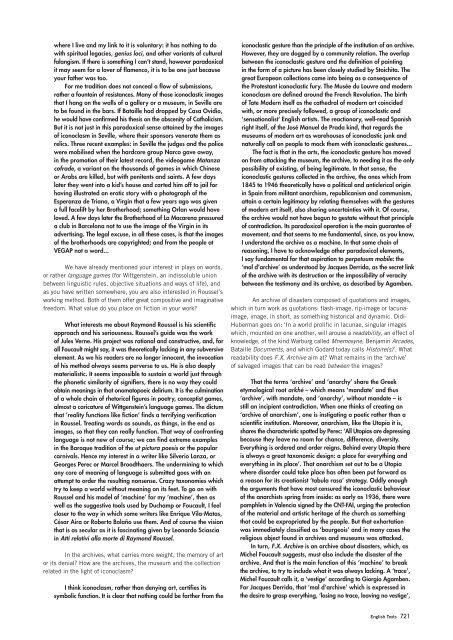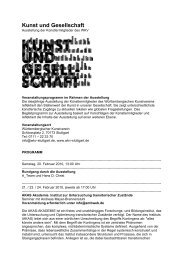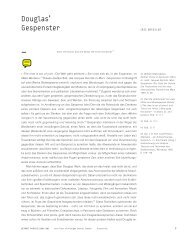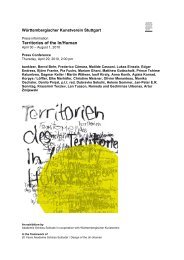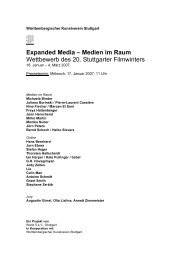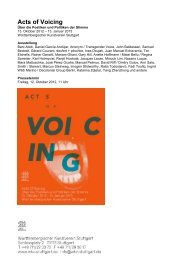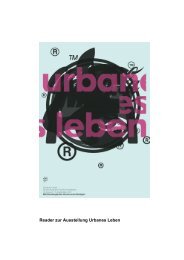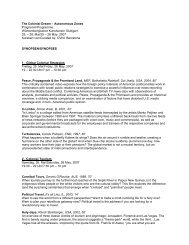English Texts
English Texts
English Texts
You also want an ePaper? Increase the reach of your titles
YUMPU automatically turns print PDFs into web optimized ePapers that Google loves.
where I live and my link to it is voluntary: it has nothing to do<br />
with spiritual legacies, genius loci, and other variants of cultural<br />
falangism. If there is something I can’t stand, however paradoxical<br />
it may seem for a lover of flamenco, it is to be one just because<br />
your father was too.<br />
For me tradition does not conceal a flow of submissions,<br />
rather a fountain of resistances. Many of those iconoclastic images<br />
that I hang on the walls of a gallery or a museum, in Seville are<br />
to be found in the bars. If Bataille had dropped by Casa Ovidio,<br />
he would have confirmed his thesis on the obscenity of Catholicism.<br />
But it is not just in this paradoxical sense attained by the images<br />
of iconoclasm in Seville, where their sponsors venerate them as<br />
relics. Three recent examples: in Seville the judges and the police<br />
were mobilised when the hardcore group Narco gave away,<br />
in the promotion of their latest record, the videogame Matanza<br />
cofrade, a variant on the thousands of games in which Chinese<br />
or Arabs are killed, but with penitents and saints. A few days<br />
later they went into a kid’s house and carted him off to jail for<br />
having illustrated an erotic story with a photograph of the<br />
Esperanza de Triana, a Virgin that a few years ago was given<br />
a full facelift by her Brotherhood; something Orlan would have<br />
loved. A few days later the Brotherhood of La Macarena pressured<br />
a club in Barcelona not to use the image of the Virgin in its<br />
advertising. The legal excuse, in all these cases, is that the images<br />
of the brotherhoods are copyrighted; and from the people at<br />
VEGAP not a word...<br />
We have already mentioned your interest in plays on words,<br />
or rather language games (for Wittgenstein, an indissoluble union<br />
between linguistic rules, objective situations and ways of life), and<br />
as you have written somewhere, you are also interested in Roussel’s<br />
working method. Both of them offer great compositive and imaginative<br />
freedom. What value do you place on fiction in your work?<br />
What interests me about Raymond Roussel is his scientific<br />
approach and his seriousness. Roussel’s guide was the work<br />
of Jules Verne. His project was rational and constructive, and, for<br />
all Foucault might say, it was theoretically lacking in any subversive<br />
element. As we his readers are no longer innocent, the invocation<br />
of his method always seems perverse to us. He is also deeply<br />
materialistic. It seems impossible to sustain a world just through<br />
the phonetic similarity of signifiers, there is no way they could<br />
obtain meanings in that onomatopoeic delirium. It is the culmination<br />
of a whole chain of rhetorical figures in poetry, conceptist games,<br />
almost a caricature of Wittgenstein’s language games. The dictum<br />
that ‘reality functions like fiction’ finds a terrifying verification<br />
in Roussel. Treating words as sounds, as things, in the end as<br />
images, so that they can really function. That way of confronting<br />
language is not new of course; we can find extreme examples<br />
in the Baroque tradition of the ut pictura poesis or the popular<br />
carnivals. Hence my interest in a writer like Silverio Lanza, or<br />
Georges Perec or Marcel Broodthaers. The undermining to which<br />
any core of meaning of language is submitted goes with an<br />
attempt to order the resulting nonsense. Crazy taxonomies which<br />
try to keep a world without meaning on its feet. To go on with<br />
Roussel and his model of ‘machine’ for my ‘machine’, then as<br />
well as the suggestive tools used by Duchamp or Foucault, I feel<br />
closer to the way in which some writers like Enrique Vila-Matas,<br />
César Aira or Roberto Bolaño use them. And of course the vision<br />
that is as secular as it is fascinating given by Leonardo Sciascia<br />
in Atti relativi alla morte di Raymond Roussel.<br />
In the archives, what carries more weight, the memory of art<br />
or its denial? How are the archives, the museum and the collection<br />
related in the light of iconoclasm?<br />
I think iconoclasm, rather than denying art, certifies its<br />
symbolic function. It is clear that nothing could be farther from the<br />
iconoclastic gesture than the principle of the institution of an archive.<br />
However, they are dogged by a community relation. The overlap<br />
between the iconoclastic gesture and the definition of painting<br />
in the form of a picture has been closely studied by Stoichita. The<br />
great European collections came into being as a consequence of<br />
the Protestant iconoclastic fury. The Musée du Louvre and modern<br />
iconoclasm are defined around the French Revolution. The birth<br />
of Tate Modern itself as the cathedral of modern art coincided<br />
with, or more precisely followed, a group of iconoclastic and<br />
‘sensationalist’ <strong>English</strong> artists. The reactionary, well-read Spanish<br />
right itself, of the José Manuel de Prada kind, that regards the<br />
museums of modern art as warehouses of iconoclastic junk and<br />
naturally call on people to mock them with iconoclastic gestures...<br />
The fact is that in the arts, the iconoclastic gesture has moved<br />
on from attacking the museum, the archive, to needing it as the only<br />
possibility of existing, of being legitimate. In that sense, the<br />
iconoclastic gestures collected in the archive, the ones which from<br />
1845 to 1946 theoretically have a political and anticlerical origin<br />
in Spain from militant anarchism, republicanism and communism,<br />
attain a certain legitimacy by relating themselves with the gestures<br />
of modern art itself, also sharing uncertainties with it. Of course,<br />
the archive would not have begun to gestate without that principle<br />
of contradiction. Its paradoxical operation is the main guarantee of<br />
movement, and that seems to me fundamental, since, as you know,<br />
I understand the archive as a machine. In that same chain of<br />
reasoning, I have to acknowledge other paradoxical elements,<br />
I say fundamental for that aspiration to perpetuum mobile: the<br />
‘mal d’archive’ as understood by Jacques Derrida, as the secret link<br />
of the archive with its destruction or the impossibility of veracity<br />
between the testimony and its archive, as described by Agamben.<br />
An archive of disasters composed of quotations and images,<br />
which in turn work as quotations: flash-image, rip-image or lacunaimage,<br />
image, in short, as something historical and dynamic. Didi-<br />
Huberman goes on: ‘In a world prolific in lacunae, singular images<br />
which, mounted on one another, will arouse a readability, an effect of<br />
knowledge, of the kind Warburg called Mnemosyne, Benjamin Arcades,<br />
Bataille Documents, and which Godard today calls Histoire(s)’. What<br />
readability does F.X. Archive aim at? What remains in the ‘archive’<br />
of salvaged images that can be read between the images?<br />
That the terms ‘archive’ and ‘anarchy’ share the Greek<br />
etymological root arkhé – which means ‘mandate’ and thus<br />
‘archive’, with mandate, and ‘anarchy’, without mandate – is<br />
still an incipient contradiction. When one thinks of creating an<br />
‘archive of anarchism’, one is instigating a poetic rather than a<br />
scientific institution. Moreover, anarchism, like the Utopia it is,<br />
shares the characteristic spotted by Perec: ‘All Utopias are depressing<br />
because they leave no room for chance, difference, diversity.<br />
Everything is ordered and order reigns. Behind every Utopia there<br />
is always a great taxonomic design: a place for everything and<br />
everything in its place’. That anarchism set out to be a Utopia<br />
where disorder could take place has often been put forward as<br />
a reason for its creationist ‘tabula rasa’ strategy. Oddly enough<br />
the arguments that have most censured the iconoclastic behaviour<br />
of the anarchists spring from inside: as early as 1936, there were<br />
pamphlets in Valencia signed by the CNT-FAI, urging the protection<br />
of the material and artistic heritage of the church as something<br />
that could be expropriated by the people. But that exhortation<br />
was immediately classified as ‘bourgeois’ and in many cases the<br />
religious object found in archives and museums was attacked.<br />
In turn, F.X. Archive is an archive about disasters, which, as<br />
Michel Foucault suggests, must also include the disaster of the<br />
archive. And that is the main function of this ‘machine’ to break<br />
the archive, to try to include what it was always lacking. A ‘trace’,<br />
Michel Foucault calls it, a ‘vestige’ according to Giorgio Agamben.<br />
For Jacques Derrida, that ‘mal d’archive’ which is expressed in<br />
the desire to grasp everything, ‘losing no trace, leaving no vestige’,<br />
<strong>English</strong> <strong>Texts</strong> 721


